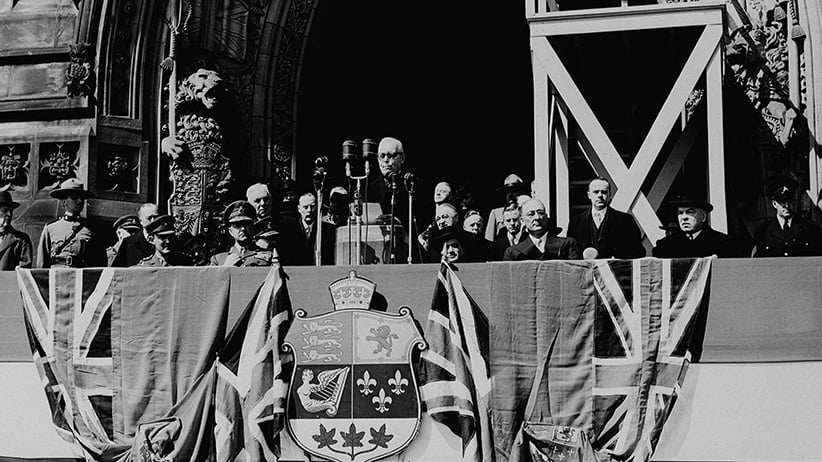‘I watched Confederation come in’
Robert Green on how Newfoundland changed after 1949
Newfoundland Confederation — Prime Minister Louis St. Laurent reads welcoming address over a nation-wide network of the C.B.C. April 1949. Seated are (left) F. Gordon Bradley, of Newfoundland, Newly-appointed Secretary of State, and former Prime Minister William Lyon Mackenzie King. (National Archives of Canada/CP)
Share
As a young boy in Bonavista Bay, N.L., Robert Green didn’t think much about Confederation. He was too busy playing hockey on the local pond, strapping Eaton’s catalogues onto his legs as makeshift goalie pads. Or waiting for the travelling movie man to come to his powerless town and set up a generator to project a film on the wall of the fishermen’s hall. Or getting a check-up aboard the Christmas Seal, a vessel that circled the Island to diagnose and treat tuberculosis.
But, as 1949 approached, Robert says, “I watched Confederation come in.” He remembers the adults trading opinions on whether the Dominion of Newfoundland should join Canada. “In those days, people would gather in somebody’s house and listen to the radio debates, argue about it and almost come to blows,” he says, recalling the rumours that swirled around about what would happen if the dominion became a province. Robert’s parents and grandparents favoured Confederation—and the living standards, social welfare and modernization it would supposedly bring—but “everyone had their own ideas.”
[widgets_on_pages id=”110-back”]
On March 31, 1949, after 52 per cent of Newfoundlanders voted for Confederation, Newfoundland became part of Canada. The next day, journalist and politician Joey Smallwood was sworn in as its first premier. Things were tense at first, Robert says, but eventually people warmed to the idea. Pension cheques certainly helped. “I think the older people thought Joey Smallwood actually took that money out of his own wallet,” he says. “To get a cheque from the government, that was a tremendous thing.”
After the decision, Robert watched his hometown, Valleyfield, change. The village got roads, then running water, and, finally, electricity. The federal government established a fish plant that, at its peak, employed up to 1,500 people. In 1954, when Smallwood’s government began offering isolated homeowners money to relocate to larger, more accessible areas, Robert’s neighbours across the harbour began floating their homes into Valleyfield. They’d prop the houses up with empty barrels, tether it to a motorboat and tow it across. “Every morning, you would get up and there would be a new house on our side of the harbour,” he says. “That doubled our population.”

The growth meant more business—and busyness—at the general store Robert had inherited from his father. “I worked there for 50 years, day and night,” he says, “from eight o’clock in the morning to two in the night.” Living with his wife in the same building as the store, Robert got to know everyone in town. But when everyone was a friend, “people knew you lived there and, of course, they’d come and torment you after you were closed.”
After Robert retired and moved to St. John’s, people often asked how long he’d worked. Reckoning he’d put in 16-hour shifts every day since graduating high school, he’d answer, “100 years.” These days, Robert works three days a week as a security guard for Canadian Blood Services—a gig he took after a years-long break from work altogether. After “100 years” on the job, he’d earned it. — Luc Rinaldi
(Portrait by Andrew Tolson)
[widgets_on_pages id=”1930s”]
[widgets_on_pages id=”110-post”]